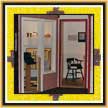 Heritage Community Foundation Presents
Heritage Community Foundation PresentsAlberta Online Encyclopedia
 |
 |
||
|
|
 |
Home | About Us | Contact Us | Partners | Sitemap |
|
|
|
 |
||
   |
|||
|
St. Albert
The beginning of St. Albert can be traced back to when Father Lacombe’s met with the Earl of Southesk at Lac Ste Anne Mission in 1859. The Earl of Southesk in turn influenced Bishop Taché to come west in 1860, thereby allowing Lacombe to show him the St. Albert location. Blessed as a mission site by Bishop Taché in January 1861, by April, the first buildings were being constructed. The site was expected to primarily serve the Métis community formerly known as Big Lake. The Sturgeon River Valley shapes the landscape of St. Albert. The slow-moving and shallow river created gentle rolling hills that are a contrast to the flat prairie surroundings. The river-lot system, styled after rural townships in Quebec, defined the majority of land parcel sizes and shapes along both sides of the Sturgeon River. Streams, ravines and drainage channels leading to the river continue to be integrated as much as possible, into the present urban landscape. The valley was named for the large fish found in the river. The mission community grew rapidly, and in 1862, to facilitate traffic between the mission and the Fort Edmonton region, the Sturgeon River was bridged. By 1863, the Grey Nuns established a school and health ministry in the community. One reason for the development of the community was the desire to introduce the Métis into an agricultural life. Many of the Métis had settled around Lac Ste Anne, but the soil was heavy and grey, lacking in loam, and the weather was cooler than in the Edmonton area. Many soon realized that the growing season at Lac Ste Anne was too short for wheat to ripen. At St. Albert, the settlers found rich black soil that was easy to work, and they hoped the area would have a longer growing season. In addition, the area had been burned by a forest fire, so clearing the land was considerably less difficult. The vegetation was different than at Lac Ste Anne, being comprised of poplars, willows and lower shrubs of the parkland, rather than the heavier bush of the taiga. The Métis people were happy to find lots of berry bushes, and enjoyed the variety of raspberries, saskatoons, pin, chokecherries, gooseberries, currants. The area was home to lots of wild fowl, whose eggs could be gathered, and spawning areas for fish. The community depended heavily on fish in the summer months, and so dried those caught during spawning season when they flooded the shallows. The Big Lake area and Sturgeon River valley are still important natural areas for water fowl and fish. Many Métis and First Nations people began attending the chapel in the area and many Métis moved into log houses built at the bottom of the hill. The Métis adapted a new lifestyle of farming instead following only the traditional way of life of hunting and fishing. As it took time to build up profitable farms, many Métis people struggled as new farmers and lived off pemmican, dried meat, wild berries, and sometimes bannock. Over time, the Métis farms spread out, and were joined by immigrants from Quebec. The French community in and around St. Albert is reputed to be the largest French-language community in Canada outside of Quebec. In 1900, St. Albert was incorporated as a village followed by town status in 1904, the community officially became a city in 1977. The modern City of St. Albert is located on Edmonton's northwestern edge. It's bordered on the south and east by the Edmonton city limits, and is separated from the riding of Spruce Grove-Sturgeon-St. Albert by McKenny Avenue and St. Albert Trail. Today St. Albert is a bustling city of more than 54,000 residents. Boasting more than 34 kilometres of trails, 1,100 acres of greenspace, the Arden Theatre, the visual arts studios, the Musee Heritage Museum and numerous special events, it's easy to see why St. Albert is renowned for its rich heritage, artistic community, and natural environment This city is also renowned for its French heritage and its "public" schools are Catholic, while the "separate" schools are Protestant. |
Fort Chipewyan and Fort Vermilion Fort Edmonton and Fort Augustus Fort George and Buckingham House St. Albert |
||
|
|
|||
 |
 |
 |
 |
For more on Métis Alberta, visit Peel’s Prairie Provinces.

